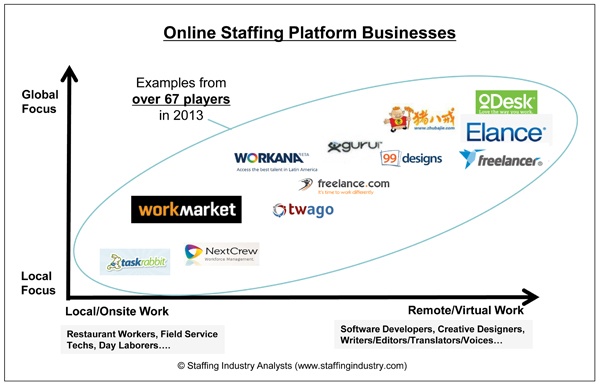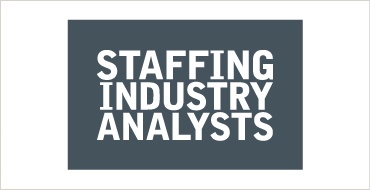Online Staffing – It Is Here And It Is About Your Business

Rod: My head-to-head partner this month is Andrew Karpie, Analyst at Staffing Industry Analysts based in the San Francisco Bay area of the United States. Andrew is responsible for developing and publishing market and industry research and analysis about online work intermediation platforms.
Andrew, I attended your presentations at Staffing Industry Analysts' Executive Forum in Orlando in February this year. Here in Australia and New Zealand there has not been much discussion of the emerging Online Staffing sector but it seems we should be thinking about it.
Andrew: I definitely think so. Over just several years, the Online Staffing segment (and that’s not counting crowdsourcing and other workforce-related platforms) reached US$1B in spend on the platforms in 2012, and we are seeing continuing growth at levels that will be quite a bit greater than 50% per annum. At this time, we are tracking at least 67 individual firms in this category scattered across the world.
What is really striking about this growing population of Online Staffing platforms is the rate at which business model innovation is occurring. This is not just 67 companies fundamentally doing the same thing, the companies have realised that this digital platform model presents many different ways for addressing different segments of labour supply and demand. For example, most people think about a global platform, like freelancer.com, that supports remote virtual workers used by small businesses.But new Online Staffing firms in past years have taken many different approaches, even supporting the hiring of on-site workers locally, effectively playing the role of traditional staffing firms.
Rod: How do you separate the blurred conversations about Online Staffing compared to Online Recruiting?
Andrew: Yes, well, these terms are frequently used rather loosely, but at Staffing Industry Analysts we've established some definitions to help with our research. For us, Online Recruiting refers to the traditional process of sourcing and recruiting candidates, but using “online methods” (such as career sites, job boards,social networks, etc.).
Online Staffing, on the other hand, is a two-sided platform model that enables specific hirers and specific (typically contingent) workers to enter into, complete, and transact work arrangements. In other words, the traditional recruiting and placement process is replaced by a “self-service online work marketplace,” and the platform enables the work arrangement online from the “posting of work” to the “payment of the worker.”
Rod: I like the quote from oDesk’s CEO, Gary Swart "Work is no longer a place. Businesses are building flexible, distributed teams which create more economic opportunity for everyone. Online work is especially empowering start-ups, as the Internet connects them with the skilled professionals they need."
Some of our reading for the preparation of this article has confirmed that the level of activity in Australia and New Zealand is higher than most recruitment industry participants would imagine. One leading company, Elance, publishes data that shows Australia is 3rd in the world behind the USA and UK for jobs posted on its site. oDesk recently reported Australia has the highest spend per capita globally for them.
Why is this sector experiencing such massive growth?
Andrew: I think we are at a very special point in time where a number of forces and development are converging. First, businesses are requiring more and more flexibility and efficiency in their work arrangements, for example, to use high-demand, limited talent on a “fractional basis” only when it is needed.
Second, new technologies and platform models have now made it possible, as never before, to arrange and even fully transact a work arrangement online - efficiently, quickly, often independent of worker and business locations.
And finally, the working population has exhibited at least two tendencies: more desire for independence and flexibility in work arrangements to cope with the complexity of living in a modern society as well as full embracing of online technologies as a major part of living and working. As you have pointed out, the working population has been getting more and more conditioned as online consumers, so behaviourally getting work online is not seeming that different from getting books or music online.
Related: The Staffing Industry and Government Regulation – A Global Discussion
So there is a happy coincidence in all of this. But one other important explanation is that these online work arrangement platforms can be highly and rapidly scalable for a variety of reasons—one of those reasons is “they deliver.”
Rod: The job breakdown for Elance in Australia is interesting – 44% of the jobs posted are creative,39% IT, 8% operations and 7% marketing. These are the types of jobs you would expect to be handled online but do you see any trends to new job categories?
Andrew: Yes, definitely. Just in terms of the type of work that can be performed online, remotely, we are seeing growth in business and administrative jobs such as finance, accounting, legal,customer service or in disciplines like engineering and architecture.
These platforms are also a way to address the supply and demand problem of “short-tail” types of work (for example, specialists in a certain area of bioinformatics).
However, as I mentioned already, we are also seeing online platform models address supply and demand of onsite workers (ranging from food and event catering workers to field service technicians for electronics products or machinery)—workers that maybe low cost and transient, or work arrangements that may be very episodic and geographically dispersed.
There are a number of businesses in the US heading in this direction, TaskRabbit being the most popularized. But I am seeing this trend emerging in other industries, including mineral extraction and oil and gas, industries that are not unimportant in Australia.
Rod: Andrew, this is both an exciting and scary article. If a recruitment owner or manager is reading this then they are seeing an emerging model that is here now, it bigger than imagined, is growing rapidly, and is expanding into new job categories. What strategies should recruitment agencies be putting in place to ensure their viability?
Andrew: I don’t think there is any alternative than to go with the flow. I don’t mean try to go out and become a freelancer.com. I mean look seriously at these online staffing models and ask yourself how we can be more like them in terms of end-to-end integrated automation. If the talent supply chain is rationalised, then that leaves more time for staffing firms to focus on effective, valuable service for clients that machines cannot provide.
I am seeing start-up staffing firms in the US and the UK that are getting launched with this model. I also see staffing firms thinking about whether this more efficient model can be adopted to low margin types of job requirements.
Finally, I think there is a need to go beyond any biases one might have about what business clients really want. Business clients want quality, but faster and cheaper as well. Moreover, if you look more carefully, you will probably see that your clients are starting use online workers, because it’s something these businesses need and want. Ignoring emerging client needs for new kinds of work arrangements is probably not a good strategy for work arrangement intermediaries— it is perhaps better to think in terms of new markets and products, and new ways to grow.
Andrew Karpie – Bio
Andrew Karpie is a Staffing Industry Analysts Affiliate Analyst, covering online staffing, the human cloud and other areas of staffing technology. He has an extensive background as an analyst, manager, and consultant at the intersection of IT and services industries. He holds an MS in Quantitative Policy Analysis from Carnegie Mellon University. Further information on SIA is available at http://www.staffingindustry.com/
Originally Published in published in Recruitment Extra September 2013


 By
By




